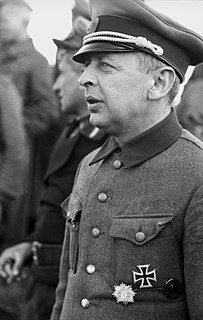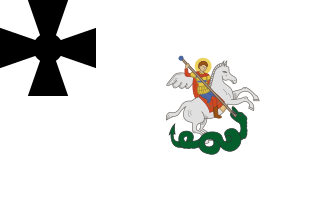
Novogrudok is a city in the Grodno Region of Belarus.

Bronislav Vladislavovich Stroganof Kaminski was a Russian anti-communist collaborationist and the commander of the S.S. Sturmbrigade R.O.N.A., an anti-partisan formation made up of people from the so-called Lokot Autonomy territory in the Nazi Germany occupied areas of Russia, which was later incorporated into the Waffen-SS as the S.S. Sturmbrigade R.O.N.A.. Older publications mistakenly give his first name as Mieczyslaw.

The Lokot Autonomy or Lokot Republic comprised a semi-autonomous region in Nazi German-occupied Central Russia from 1941 to 1943. Bronislav Kaminski's administration controlled the area from July 1942 to August 1943. The name is derived from the region's administrative center, the urban-type settlement of Lokot in Oryol Oblast.

The Soviet partisans were members of resistance movements that fought a guerrilla war against the Axis forces during World War II in the Soviet Union, the previously Soviet-occupied territories of interwar Poland in 1941–45 and eastern Finland. The activity emerged after Nazi Germany's Operation Barbarossa was executed from mid-1941 on. It was coordinated and controlled by the Soviet government and modeled on that of the Red Army. The partisans made significant contributions to the war by frustrating German plans to exploit occupied Soviet territories economically, gave considerable help to the Red Army by conducting systematic strikes against Germany's rear communication network, disseminated political work among the local population by publishing newspapers and leaflets, and succeeded in creating and maintaining a feeling of insecurity among German forces.
The 3rd Army was a field army of the Red Army during World War II.
Many Latvians resisted the occupation of Latvia by Nazi Germany. The Latvian resistance movement was divided between the pro-independence units under the Latvian Central Council and the pro-Soviet units under the Central Staff of the Partisan Movement in Moscow. Daugavpils was the scene of fierce Jewish resistance during the Holocaust. Many local Latvians were actively involved in the resistance movement against the ethnic policies of the German occupation regime. Žanis Lipke risked his life to save more than 50 Jews. 134 Latvians were later honored with the title Righteous Among the Nations.

The Belarusian resistance during World War II opposed Nazi Germany from 1941 until 1944. Belarus was one of the Soviet republics occupied during Operation Barbarossa.

Oleg Vasilyevich Koshevoy was a Soviet partisan and one of the founders of the clandestine organization Young Guard, which fought the Nazi forces in Krasnodon during World War II between 1941 and 1945.
During the Great Patriotic War of 1941–1945, a Soviet partisan united formation (1941–1944), also called a military-operational group or a centre, became one of the organisational forms which grouped together various Soviet partisan units. A united formation linked several of the smaller partisan units - partisan brigades or regiments or detachments - with a view to conducting wide-scale and center-coordinated military operations in the rear of occupying Axis forces.
A partisan group was the smallest organizational form of the Soviet partisan units, the principal organizational form in the initial phase (1941—1942) of the partisan war in the German rear.
Soviet partisan detachment (1941—1944), was the main organisational form of the Soviet partisan units.

The Bulgarian Resistance was part of the anti-Axis resistance during World War II. It consisted of armed and unarmed actions of resistance groups against the Wehrmacht forces in Bulgaria and the Tsardom of Bulgaria authorities. It was mainly communist and pro-Soviet Union. Participants in the armed resistance were called partizanin and yatak.

World War II in Yugoslav Macedonia started with the Axis invasion of Yugoslavia in April 1941. Under the pressure of the Yugoslav Partisan movement, part of the Macedonian communists began in October 1941 a political and military campaign to resist the occupation of Vardar Macedonia. Officially, the area was called then Vardar Banovina, because the very name Macedonia was prohibited in the Kingdom of Yugoslavia. It was occupied mostly by Bulgarian, but also by German, Italian, and Albanian forces.

The Nachtigall Battalion, also known as the Ukrainian Nightingale Battalion Group, or officially as Special Group Nachtigall, was the subunit under command of the German Abwehr special operations unit Lehrregiment "Brandenburg" z.b.V. 800. Along with the Roland Battalion it was one of two military units formed February 25, 1941 by head of the Abwehr Wilhelm Franz Canaris, which sanctioned the creation of the "Ukrainian Legion" under German command. It was composed of volunteer "Ukrainian nationalists," Ukrainians operating under Stephan Bandera's OUN orders.

Resistance to the German occupation of the Protectorate of Bohemia and Moravia during World War II began after the occupation of the rest of Czechoslovakia and formation of the protectorate on 15 March 1939. German policy deterred acts of resistance and annihilated organizations of resistance. In the early days of the war, the Czech population participated in boycotts of public transport and large-scale demonstrations. Later on, armed communist partisan groups participated in sabotage and skirmishes with German police forces. The most well known act of resistance was the assassination of Reinhard Heydrich. Resistance culminated in the so-called Prague uprising of May 1945; with Allied armies approaching, about 30,000 Czechs seized weapons. Four days of bloody street fighting ensued before the Soviet Red Army entered the nearly liberated city.
The Soviet partisans in Latvia were Soviet partisans who were deployed to Latvia and attempted to wage guerrilla warfare against the German armed forces during the German occupation of Latvia. Partisan activity was singularly unsuccessful in Latvia due to the general resistance of the population to the Soviet regime that the partisans represented.
Destruction battalions, colloquially istrebitels abbreviated: istrebki (Russian), strybki (Ukrainian) were paramilitary units under the control of NKVD in the western Soviet Union, which performed tasks of internal security on the Eastern Front and after it. After the Fall of the Soviet Union the battalions were deemed to be a criminal organisation by the Estonian government.
The Schutzmannschaft Battalion 201 was a World War II Ukrainian Schutzmannschaft auxiliary police battalion formed by Nazi Germany on 21 October 1941, predominantly from the soldiers of Ukrainian Nachtigall Battalion dissolved two months prior and the Roland Battalion. The battalion was part of the Army Group Centre that operated in Belarus.

The 1st Czechoslovak Partisan Brigade of Jan Žižka, initially known as Ušiak-Murzin Unit, was the largest partisan unit in the Protectorate of Bohemia and Moravia during the German occupation of Czechoslovakia. After its core membership of Soviet-trained paratroopers were dropped into Slovakia in August 1944, the brigade crossed into Moravia and began operations in earnest at the end of 1944. Its focus was guerrilla warfare, especially sabotage and intelligence gathering.










